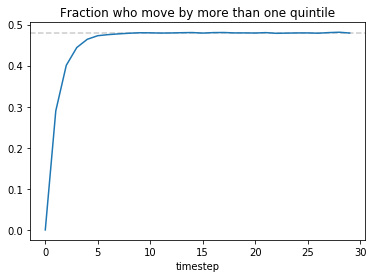Tick 2. Economic mobility¶
Some degree of inequality might be acceptable if economic mobility were high, i.e. if everyone had similar chances of reaching either end of the wealth distribution. Economic mobility is often measured by splitting the population into five equal brackets ("quintiles"), and measuring the chance of moving between brackets. From a report by the Brookings Institute,
Contrary to American beliefs about
equality of opportunity, a child’s economic position is heavily influenced by that of his
or her parents. 42% of children born to parents in the bottom fifth of the income
distribution remain in the bottom, while 39% born to parents in the top fifth
remain at the top.
Let's measure economic mobility by recording the wealth distribution at one timepoint, and again some number of timesteps later, splitting the two distributions into quintiles, and counting what fraction of the population moved by more than one quintile from beginning to end. (In each timestep a median individual might find their wealth increasing or decreasing by around 50%, so one timestep corresponds roughly to several years of human life.) For example, if we have a population of 5000 and we draw up a matrix $A$ where $A_{i j}$ is the number of people who start in quintile $i$ and end up in quintile $j$, we might get
$$
A = \left( \begin{matrix}
344& 313& 243& 100& 0\\
266& 261& 302& 167& 4\\
212& 260& 225& 272& 31\\
147& 143& 183& 331& 196\\
31& 23& 47& 130& 769
\end{matrix} \right)
$$
(A quick check: the row sums and column sums are all 1000.) The number who moved by more than one quintile is 1148, which is 23% of the population.
